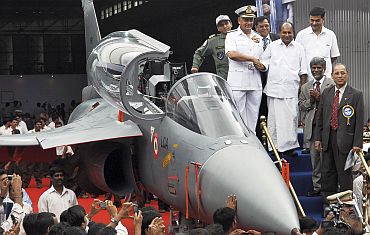Philip wrote:One problem that the naval variant will have is weaponload.The naval version will have to carry anti-ship missiles,most probably air launched versions of Uran,apart from other anti-air missiles.Now it will have to land with these weapons as well as during peacetime exercises,as it cannot dump into the sea such expensive ordnance.Therefore landing with a ful load of weaponry will require the undercarriage to be able to take the extra stress when performing carrier landings unlike the air force vesrion.
Well Philip, any aircraft will have a max landing weight and it's maximum bring back load will depend on that. It doesn't matter it is an AF version or a Navy version. For eg, a Jaguar IM will not dump a Sea Eagle missile while landing, or for that matter a Mirage 2000 will not dump it's 500kg LGB loads just to land. In such cases, they will make sure that the fuel is used up /dumped so that they come within the bring back load the undercarriage is designed for.
What is different is that there is no final "flare" in a carrier landing, so the stresses are higher because of the higher sink rate. So the undercarriage and structure needs to be beefed up when compared to a land version (which will flare while landing) for a given bring back load.
The angle of descent when landing will also have to ensure that none of the ordnance hits the deck first too,especially an anti-ship missile!
That is why the Brits were so happy with the Harrier as Harrier vertical landings were tension free and plumped for the STOVL version of the JSF
The STOVL is an evolutionary dead end. The only reason why it is even happening is because the US has the USMC. Now if the proposal to merge the USMC and USNavy are done for any reason, the USMC carriers will get the chop and with that go the STOVL versions of JSF.
STOBAR and STOVL impose tremendous penalties in aircraft load and range. You actually always need to have a thrust to weigth of 1 or more at take off for an STOVL. For eg, a A6 intruder will have a t:w of 0.5 or so and still have a far greater range and payload than a STOBAR carrier launched Mig 29 or SU33 even. The STOBAR imposes sever size limits as well. I think it is the correct decision that Indian Navy made to go CATOBAR in IAC upwards.
I wish that the IN also get involved with the PAK-FA 5th-gen fighter and examine the possibility of acquiring a STOVL version of it,which would also be very useful for the Russians who plan to build several carriers in the future.Such a design would obviate the need for a catapult aboard a larger deck.
A STOVL version of PAK_FA doesn't exist, and even if it did, it would be so compromised in performance to be nearly a dud. Just think of it, taking and landing a 30ton beast vertically takes massive engine thrust.. It needs atleast 30ton!. A catapult is a far wiser and proven solution.
I am willing to take a Rs 100 bet with you. The next gen /new gen Russian carriers (if they start a new program) will be CATOBAR and NOT STOBAR or STOVL.




